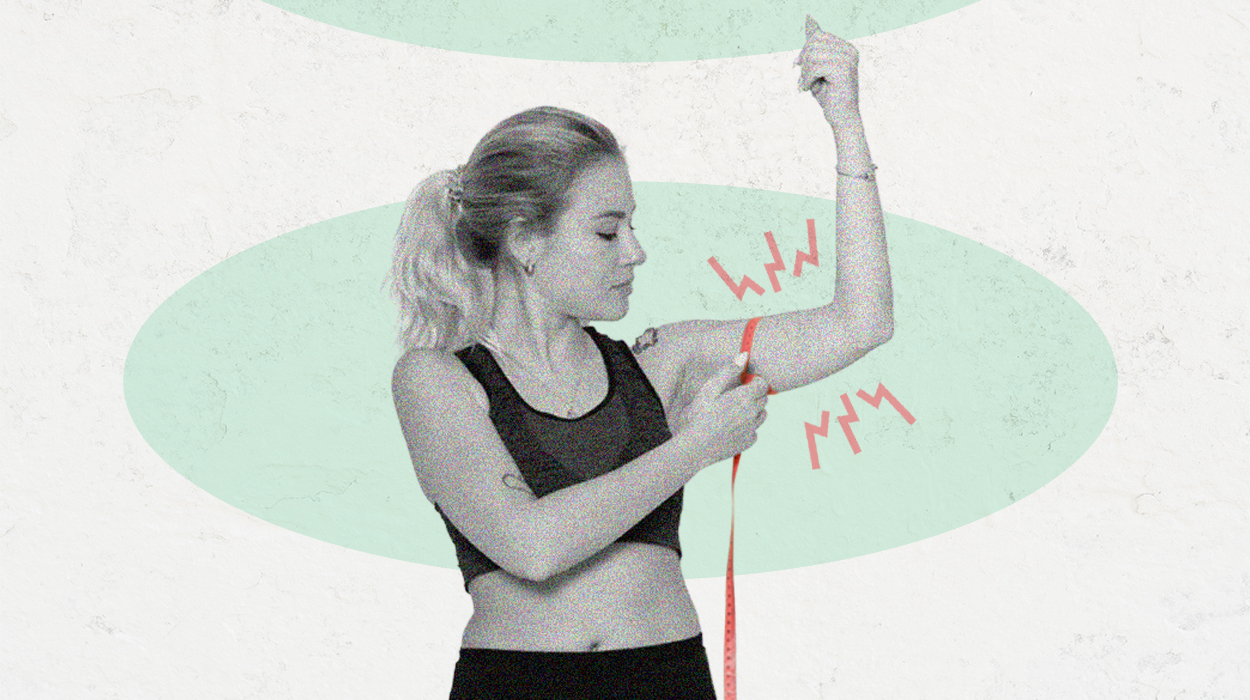How To Lose Arm Fat: 10 Effective Ways To Tone Arms In 2 Weeks 2024

Most of us would like to lose a few pounds here or there. Keeping weight off is tough. Worse, body fat always seems to collect in the most unsightly places. Flabby arms are a common source of embarrassment and may be difficult to conceal.
While it would be nice, there is, unfortunately, no way to focus a workout to burn fat in a specific place. However, that doesn’t mean you can’t tighten up your arms and feel more confident. It’s possible to see real results, even in just a couple of weeks.
How To Lose Arm Fat Fast
The reality is that it’s not possible to burn fat in a specific part of the body, targeting a particular area for weight loss[1]. This strategy, called spot reduction, doesn’t work because your body will burn fat more or less evenly across your body. To lose weight in a particular area, you have to lower your overall body fat.
Exercising or strengthening a particular muscle group, for example, the triceps in the arms, can tighten and add definition to that area. In other words, you can tighten up muscles so that the underside of your arms will wobble less. It won’t have a huge impact on the amount of fat on your arms, however.
If your goal is to feel more confident about your arms and how they look, the best approach may be to combine both of those approaches. You’ll want to follow strategies for losing extra body weight, like doing cardio and eating a good diet. You’ll also want to do strength training focusing on your upper body.
By improving your diet, doing cardio exercises regularly, and adding strength training to your workouts, you can have tight, shapely arms in no time. It’s possible to lose as much as 12 pounds of body weight in about two weeks in a healthy way.
How To Lose Arm Fat In 2 Weeks With 10 Best Ways
Add Healthier Foods

There are lots of tricks for improving your diet, from pre-measured meals to cutting out specific types of food. The simplest and easiest, though, might be to just add more healthy food to your diet.
Most people dread going on a diet, even a temporary one because it means cutting out all of your favorite foods. However, there’s a more positive way to look at it. Don’t focus so much on the foods you’re not going to eat. Instead, try to add new, healthier foods to the diet you’re already on.
You can still eat a burger, you just have to eat a salad first. Add fresh fruit to ice cream for dessert, instead of layering it in chocolate sauce. Now, you do have to make sure to eat a healthy diet. Ideally, you’d eat them first so that they fill you up and you’re less hungry for junk.
Form Healthier Eating Habits
It doesn’t help much to add a salad to dinner if you’re snacking on a candy bar or bowl full of pretzels between meals. A big part of eating healthy is changing some of the habits we’ve formed around food.
These sorts of habits can take a couple of different forms. First, try to limit snacking between meals, or cut it out altogether. Also, pick a time in the evening after which you won’t eat anymore. If you eat and then sleep soon after, a greater part of the calories you consume are going to go to fat as they aren’t being burned by activity.
Other habits include things like setting a specific time for dinner each day. You might make an effort to sit down without the TV going or your phone to play with.
Making eating a social event can also be a great way to improve your relationship with food. For example, if you spend time making dinner with friends or family, enjoying each others’ company, cooking dinner each night may not seem like such a chore.
Track Your Weight
There are few things that are more motivating than seeing exactly how much progress you’ve made. Weighing yourself each day allows you to see how far you’ve come and how far you’ve yet to go. It can also help you figure out what fat loss strategies are most effective for you.
It’s possible to go overboard tracking the fluctuations in your weight. It may bounce up and down during the day, or vary depending on what you’re doing or what you’re eating.
A good rule of thumb is to pick one specific time each day to weigh yourself. It can make tracking progress a lot easier and less frustrating.
The best time to weigh yourself is first thing in the morning, after getting out of bed. You haven’t eaten anything or burned any calories yet, so you’re tracking your base weight.
Regular Cardio Exercise
It’s really hard to lose fat through dieting alone. This is particularly true if your activity level is pretty low. You can’t lose weight if you’re not burning calories.
The best way to burn excess fat is through cardiovascular exercise. Strength training is, as the name implies, all about building stronger muscles. However, the sort of focused workout that is best for strength training only activates one or a few muscle groups. As a result, relatively few calories are burned.
If you want to lose arm fat fast, as part of general weight loss, cardio is the way to go. Getting your cardiovascular system going burns a lot more calories and will help you trim down fat quickly.
The recommended amount of cardio is between 150 and 75 minutes a week, depending on the intensity of the workout. Of course, you can do more. Anything that gets your heart rate up qualifies. You can go jogging, but you could also swim, play basketball, or do a bunch of other things.
Make Physical Activity Routine

There are lots of opportunities to add a little more activity into your life. If your workouts are wearing you out, more exercise may not be a good idea. However, if you’re motivated you can do things like take the stairs instead of the elevator or park further away from the door.
You could also just go for a walk each day. After dinner may be the best time, as you can actually burn off some of the calories you just consumed. That prevents them from being turned into fat.
Resistance Training
While lifting weights may not reduce extra arm fat, it can tone your arms. A certain amount of the sagginess in saggy arms comes from weak and flabby arms muscle. Skin and fat hang from the upper arms, unsupported by the underlying muscle.
Losing arm fat is only half the equation if you want to strengthen, define, and tone your arms. Toning arms tighten upper arm muscles so that you won’t have to worry about flabby arms anymore.
Weight training is the standard form of resistance training. You don’t have to work on the bench press. In this case, you do want to target your workouts. Weight machines can be great if you’re less sure of your form. They can provide support and control so you’re less likely to strain something.
Bicep curls and tricep extensions are good exercises to start with. Free weights can often be a more efficient way to work out than machines. A certain amount of energy has to be used to stabilize and control the weight, instead of letting the machine do that for you.
Bodyweight exercises are another good option that doesn’t require much equipment. Tricep dips, for example, can be done with a regular chair. Push-ups are also always a good option.
Bicep curls and tricep dips are just two of the many exercises that can strengthen your upper body and reduce the appearance of upper arm fat.
Eat More Protein
Building muscle is part of building lean body mass and can help you lose weight. Exercising can only get you so far when trying to build muscle mass. You also need all the ingredients your body needs for muscle growth.
Best of all, eating more protein doesn’t necessarily mean eating more calories.
Be wary of protein supplements. These supplements are often aimed at people who are more focused on building muscle than losing weight. That takes energy, so protein supplements usually include a bunch of carbs as well.
If you’re more focused on losing weight, that’s counter-productive. It’s just extra calories you’ll have to burn off, slowing weight loss.
It’s generally best to try to get all your protein from your diet. Foods like red meat, fish, and beans are great sources of protein that don’t have the downsides of supplements.
Try Interval Training
If you’re trying to lose arm fat fast, you might want to look at high-intensity interval training[2]. There are lots of programs that follow this general outline. Basically, you alternate a more intense exercise with a less demanding activity.
You can pack more body fat-burning activity[3] into a smaller amount of time. It’s also easier to keep things interesting, as you can change exercises or simply vary the intensity of the same exercise.
High impact interval {HIIT) training has also been shown to increase your metabolism for a number of hours after your workout, so you continue burning excess body fat throughout the day.
Get Enough Rest
There may be a temptation to work out as much as possible, particularly when you’re trying to see results quickly. However, to lose weight in a healthy way you need to get some rest. Taking a break can help you lose stubborn body fat in a couple of ways.
While it may not help you lose arm fat, it can help improve muscle tone. As we already mentioned, exercising causes little tears in muscle tissue. You build new muscle when those tears are repaired.
It’s during rest periods that those repairs are carried out. If you never give your muscles a chance to recover, you won’t build muscle to the same degree.
Secondly, and perhaps surprisingly, you can burn fat while you sleep[4]. We said earlier that you shouldn’t eat before going to bed as that energy won’t get burned. That’s true. However, the human body is an immensely complex machine and the amount of sleep you get has an effect on your metabolism[5].
There’s a lot going on in our bodies without our knowledge. Our metabolism will change, burning energy either faster or slower, depending on our sleeping, eating, and exercising habits. When you sleep less, your body begins to slow down your metabolism to stretch the calories it has across the longer, more active waking hours.
When you get a healthy amount of sleep, your metabolism starts burning more calories again.
Stretch Regularly
Most people don’t normally think of stretching as really being exercise. It’s something you do before exercise (and after, if you know what’s good for you) in order to warm up and get limber. However, there is evidence that spending even just a few minutes stretching can increase your heart and respiration rates[6].
You aren’t going to burn as many calories as you would jogging or doing another intense cardio workout. However, every little bit can help. Stretching can also be good for people who might have problems with lifting weights. It’s also just generally good for your health. A gentle stretching routine can be both relaxing and a good way to increase your heart rate and burn a few calories. Yoga or Pilates can have similar benefits with a more intense exercise level.
What Are Some Upper Arm Exercises?
These exercises won’t target arm fat in particular. However, they will help burn some calories. Stubborn arm fat can also collect in the upper arms. Tightening and strengthening those muscles[7], the triceps, biceps, and deltoids can help tone your arms.
If you head to the gym, you can head for the exercise machines or the free weights. Many people are looking for workout options that don’t require gym equipment, or any equipment at all, however.
These exercises[8] focus on strengthening and toning your upper arms but don’t require any equipment. Remember to start small and work up to more intense workouts.
Push-ups
The basic, classic, exercise for the upper arms and chest. Keeping your back and knees straight, support yourself on your hands and toes. Your hands should be directly under your shoulders. Bend your elbows, lowering yourself gradually while still keeping your back and knees straight. Push back up to the starting position.
A lot of people have a hard time with these at first. You can start by supporting yourself on your knees, instead of your toes. You can also make this easier by turning it 90 degrees, leaning in toward a wall and doing your push-ups vertically.
Bench Dips
You’ll need a chair that will remain stable. Turn your back to it and lower yourself so your knees are bent and your hands are resting on the seat of the chair, palms facing down. Bend your arms to lower yourself down toward the ground. Then straighten your arms once more to return to the starting position.
Tricep Kickbacks
This one is pretty simple. Kneel on your right knee with your hands by your sides. Extend your left arm back, stretching it as far as you can without discomfort. Relax and repeat several times. Switch knees to exercise the other arm.
It’s not unusual to wonder, ‘how do you lose weight on your arms?’ The answer is that you have to lose weight everywhere, improving your health and fitness generally. Tightly toned arms are the least of the benefits you’ll experience by eating healthier and staying active.
+ 8 sources
Health Canal avoids using tertiary references. We have strict sourcing guidelines and rely on peer-reviewed studies, academic researches from medical associations and institutions. To ensure the accuracy of articles in Health Canal, you can read more about the editorial process here
- Perry, E. (2011). Targeted Fat Loss: Myth or Reality? – Yale Scientific Magazine. [online] Yalescientific.org. Available at: https://www.yalescientific.org/2011/04/targeted-fat-loss-myth-or-reality/
- Journal of Applied Physiology. (2020). High-intensity interval training for health and fitness: can less be more? | Journal of Applied Physiology. [online] Available at: https://journals.physiology.org/doi/full/10.1152/japplphysiol.01237.2011
- Wisløff, U., Ellingsen, Ø. and Kemi, O.J. (2009). High-Intensity Interval Training to Maximize Cardiac Benefits of Exercise Training? Exercise and Sport Sciences Reviews, [online] 37(3), pp.139–146. Available at: https://journals.lww.com/acsm-essr/fulltext/2009/07000/high_intensity_interval_training_to_maximize.6.aspx
- Psychology Today. (2020). Sleep More, Burn More Fat. [online] Available at: https://www.psychologytoday.com/us/blog/the-source-healing/201010/sleep-more-burn-more-fat#:~:text=Translation%3A%20When%20you%20sleep%20less,burned%20in%20just%20one%20week.
- Harvard Health. (2018). The truth about metabolism – Harvard Health. [online] Available at: https://www.health.harvard.edu/staying-healthy/the-truth-about-metabolism
- Kruse, N.T. and Scheuermann, B.W. (2017). Cardiovascular Responses to Skeletal Muscle Stretching: “Stretching” the Truth or a New Exercise Paradigm for Cardiovascular Medicine?. Sports Medicine, [online] 47(12), pp.2507–2520. Available at: https://link.springer.com/article/10.1007/s40279-017-0768-1
- Alshammari, S.M. and Bordoni, B. (2021). Anatomy, Shoulder and Upper Limb, Arm Muscles. [online] Nih.gov. Available at: https://www.ncbi.nlm.nih.gov/books/NBK554420/
- NHS Choices (2021). 10-minute upper arms workout – Exercise. [online] Available at: https://www.nhs.uk/live-well/exercise/10-minute-upper-arms-workout/



